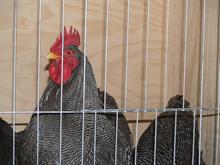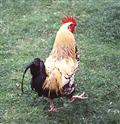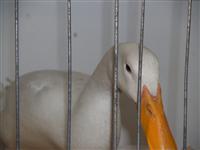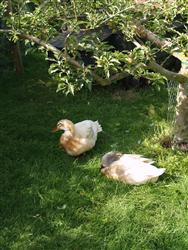Learn About The Biology, Husbandry, And General Management Of Chickens And Other Fowl
Explore the possibilities for a commercial farm with this comprehensive treatment of fowl. In this course, you'll study contract growing, different types of production, and develop the skills to manage a small flock of birds in a domestic setting. An excellent foundation course.

Course Duration: 100 hours
Course Structure
There are eight lessons in this course.
- Introduction, Terminology and Breeds
- History of Poultry
- Terminology
- Contract Growing
- Regulations
- Management Factors
- Small Scale Production
- Breeds
- Classifying Fowls (Egg Laying Breeds, Meat or Table Birds, Dual Purpose Breeds)
- Cross Breed Poultry
- Sex Linkage
- Brooders
- Skeletal System
- Poultry Husbandry (Stock Selection, Feeding, Watering, Housing, Health)
- Turkeys
- Geese
- Ducks
- Poultry Nutrition
- Digestive System (Gullet, Crop, Proventriculus, Gizzard, Intestine, Caecum, etc)
- Nutrient Sources (Carbohydrate, Protein, Minerals etc)
- Rationing
- Palatability
- The End Product
- Modern Feed Requirements
- Phase Feeding
- Limited Feeding
- Consumption Feeding
- Diseases
- Layers
- Extensive (free-range) System
- Semi-Intensive System
- Intensive Systems
- Housing
- Deep Litter System
- Feeders
- Battery Units
- Feeding the Laying Hen
- Replacing the Flock
- Broilers
- Caponising
- Brooding Period
- Feeding Broilers (Starter Period, Finisher Period)
- Housing
- Hygiene and Health
- Incubation
- The natural method (using broody hens)
- The artificial method (using incubators)
- Selecting Eggs
- Storing Hatching Eggs
- Turning Eggs
- Managing a Incubator (Temperature, Humidity, Testing, Hatching)
- Reasons for Poor Hatchability
- Brooding
- Heating
- The canopy brooder
- The infra-red lamp
- The battery brooder
- The hay box brooder
- Feeders
- Drinkers
- Floor Space
- Rearing
- Problems during rearing
- Record Keeping, economics and Marketing
- Growth Records
- Egg Production records
- Small Scale Business
- Compatible Ventures (Manure, etc)
- Preparing a Farm Business plan
- Finance3
- Land Management
- Analyzing the Market place
- Developing a Marketing Plan
Enrol Today
Ready to get started? Click on the orange enrol now button.
Have questions? Click here to email our course counsellors.
Keeping Your Birds Healthy
Chickens are known to be susceptible to many diseases. But you can prevent this as much as possible with proper care – I have always found the following good rules for you to use when caring for my hens:

- Provide your pets with a balanced diet and make sure the feed is free from mould and chemical contaminants (like pickled grain).
- If you use deep litter for your hens then keep their litter dry; Coccidiosis (an intestinal infection) and worms become a problem with wet litters.
- Provide them with a comfortable environment (temperatures between 10 and 32 degrees C). Clean out feeders and drinkers regularly and remove any rubbish.
- Isolate your new birds for at least 10 days to observe if they have any disease.
- Watch for early signs of disease — (reduced activity and noise, difficult breathing, abnormal gait or posture, changes in comb or shank colour, discharge or crusting around eyes and nostrils, ruffled feathers, unusual smells, sudden changes in feed or water consumption, decreased egg production). Sick or dead birds should be removed promptly.
- Prevent cannibalism. This requires sufficient space in the coop, escape areas such as roosts, distractions such as a bale of straw or a cabbage hung from the roof. Injured birds should be removed and treated as soon as possible.
General signs of disease and ill health include:
- fluffed feathers
- increased sleeping and closed eyes
- general lethargy and inactivity
- lack of strength (weakness)– unable to perch
- losing balance or walking in circles
- changes in breathing rates, coughing or wheezing
- discharges of nostrils
- sticky eyes, cloudy eyes
- swelling on the body
- lack of preening
- vomiting
- changes in droppings – consistency and colour
- raised or lowered skin temperature
- weight loss
Some common poisons found in and around the house or property may be easily accessible depending on how you restrict your chickens or confine their movements. They following list of items should be considered as poisonous when thinking about health management:

- Any form of cleaning product interior/outdoor household use
- Paint remover/thinner, turpentine and paint
- Rodenticides, pesticides, insecticides, ant syrup
- Weed killers
- Gasoline or diesel
- Charcoal lighters, matches, kerosene or lighter fluid
- Avocado, mushrooms
- Certain plants including poinsettia or mistletoe and more
- Sun tan lotion, hair dye, shaving lotion, drugs, nail polish, corn/wart remover
- Crayons, deodorants, fabric softener, glue, moth deterrents, silver and brass cleaner
Working in the Industry

The poultry industry today is diverse and calls for employees ranging from scientists to farm hands through to production managers, business managers and marketing specialists. Most employees need to be highly skilled to work in this field; the industry demands skilled workers. There is also a shortage of skilled workers so opportunities exist to forge a successful and profitable career within this industry.
Getting Work in the Industry
There are several ways to enter the poultry industry:
If you are employed in an agricultural position within another sector there are opportunities to move across – those with some agricultural experience are viewed very favourably.
Start at an entry level position as a farm hand and then move into an assistant poultry hand position. You may need to undertake extra educational courses in order for your career to develop from there.
- The business may provide an internship of some sort, while you study by distance education.
- As a casual worker with or without some agricultural experience.
- As a formally trained poultry specialist
The main skill sets required in the poultry industry as a poultry hand:
- Handling chickens
- Sexing chickens
- Hatchery maintenance
- Operation of equipment and machinery
- Workplace health and safety